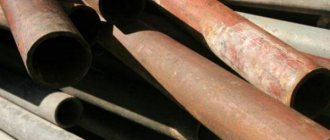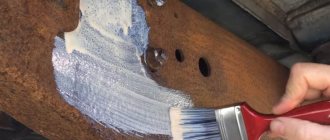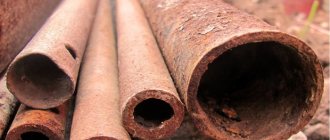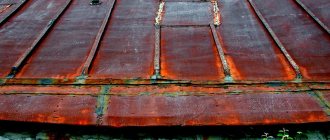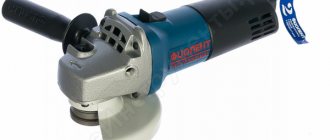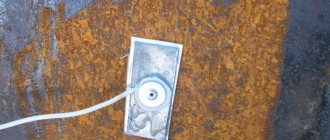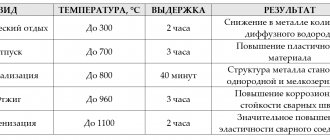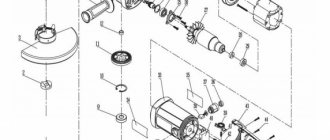Electrochemical protection is an effective way to protect finished products from electrochemical corrosion. In some cases it is impossible to renew the paint coating or protective wrapping material, then it is advisable to use electrochemical protection. The coating of an underground pipeline or the bottom of a sea vessel is very labor-intensive and expensive to renew, sometimes simply impossible. Electrochemical protection reliably protects the product from corrosion, preventing the destruction of underground pipelines, ship bottoms, various tanks, etc.
Electrochemical protection is used in cases where the potential for free corrosion is in the area of intense dissolution of the base metal or repassivation. Those. when there is intense destruction of metal structures.
Definition of corrosion
Metal materials under chemical or electrochemical influence of the environment are subject to destruction, which is called corrosion.
Corrosion of metals is caused by redox reactions, as a result of which metals become oxidized and lose their properties, which renders metal materials unusable.
There are 3 signs that characterize corrosion:
- Corrosion is, from a chemical point of view, a redox process.
- Corrosion is a spontaneous process that occurs due to the instability of the thermodynamic system metal - environmental components.
- Corrosion is a process that develops mainly on the surface of the metal. However, it is possible that corrosion can penetrate deep into the metal.
Concept of electrochemical protection
Electrochemical protection of equipment and structures made of metals is a set of measures taken to prevent corrosion processes and maintain the operability of protected objects during operation. The main result of using ECP products is the protection of engineering communications from the effects of corrosion, which entails huge economic losses due to premature wear of equipment.
The essence of ECP is to control the corrosion currents that are always generated when the metal structure and electrolyte come into contact. Through electrochemical protection, the anodic deteriorating zone passes from the protected object to anodic grounding or a third-party product made of a more active metal. As a result of a shift in the electrode potential of the metal, the spread of corrosion stops.
The main thing when installing electrochemical protection is to ensure mandatory contact between the protected structure and the external anode using a metal cable or contact and electrolyte. The electrical circuit, which includes the protected object, ECP cable, anode and electrolyte, must be closed - otherwise no protective current will arise in the system.
Types of metal corrosion
The most common types of metal corrosion :
- Uniform – covers the entire surface evenly
- Uneven
- Electoral
- Local stains – individual areas of the surface are corroded
- Ulcerative (or pitting)
- Spot
- Intercrystalline - spreads along the boundaries of a metal crystal
- Cracking
- Subsurface
Main types of metal corrosion
From the point of view of the mechanism of the corrosion process, two main types of corrosion can be distinguished: chemical and electrochemical.
Cathodic protection
A method quite often used to protect metal structures from corrosion. It is used in cases where the metal does not tend to passivate. The essence of the method is simple: an external electric current is supplied to the product from the negative pole, which ensures the polarization of the cathodic sections of the corrosion components and raises the potential value to the anodic ones. After attaching the positive pole of the current source to the anode, corrosion of the protected product becomes almost zero.
The anode requires periodic replacement, as it deteriorates over time.
- Methods of cathodic protection: polarization from an external source of electric current, inhibition of the development of the cathodic process, connection with a metal that has a more electronegative free corrosion potential in a certain environment (sacrificial protection).
- With the help of polarization, structures located in soil and water, zinc, tin, aluminum and its alloys, titanium, copper and its alloys, lead, high-chromium, carbon, low-alloy and high-alloy steels are protected from an external source of electric current.
- The role of an external source of electric current is performed by cathodic protection stations. Their main components are a rectifier, a current supply to the protected object, anode grounding conductors, a reference electrode and an anode cable.
- Cathodic protection can be used as an independent or additional method of corrosion protection.
The main indicator of the effectiveness of the method is the protective potential. Protective potential is the potential at which the rate of corrosion of a metal product becomes minimal.
However, cathodic protection has certain disadvantages. One of them is the danger of overprotection. This effect can be observed in the case of a large shift in the potential of the protected product in the negative direction. As a result, the protective shells are destroyed, and hydrogen embrittlement of the metal and corrosion cracking begin.
Electrochemical corrosion of metals
Electrochemical corrosion of metals is the process of destruction of metals in the environment of various electrolytes, which is accompanied by the appearance of an electric current inside the system.
With this type of corrosion, an atom is removed from the crystal lattice as a result of two coupled processes :
- Anodic - metal in the form of ions goes into solution.
- Cathode – the electrons formed during the anodic process are bound by a depolarizer (the substance is an oxidizing agent).
The process of removing electrons from the cathode sites is called depolarization , and substances that promote removal are called depolarizers.
The most common corrosion of metals is with hydrogen and oxygen depolarization .
Hydrogen depolarization
Hydrogen depolarization is carried out at the cathode during electrochemical corrosion in an acidic environment :
2H++2e— = H2 discharge of hydrogen ions
2H3O++2e— = H2 + 2H2O
Oxygen depolarization
Oxygen depolarization is carried out at the cathode during electrochemical corrosion in a neutral environment :
O2 + 4H++4e— = H2O reduction of dissolved oxygen
O2 + 2H2O + 4e— = 4OH—
All metals, in their relation to electrochemical corrosion, can be divided into 4 groups, which are determined by the values of their standard electrode potentials:
- Active metals (high thermodynamic instability) are all metals in the range of alkali metals - cadmium (E0 = -0.4 V). Their corrosion is possible even in neutral aqueous environments in which there is no oxygen or other oxidizing agents.
- Metals of medium activity (thermodynamic instability) are located between cadmium and hydrogen (E0 = 0.0 V). In neutral environments, in the absence of oxygen, they do not corrode, but are subject to corrosion in acidic environments.
- Low-active metals (intermediate thermodynamic stability) - are located between hydrogen and rhodium (E0 = +0.8 V). They are resistant to corrosion in neutral and acidic environments in which there is no oxygen or other oxidizing agents.
- Noble metals (high thermodynamic stability) - gold, platinum, iridium, palladium. They can be subject to corrosion only in acidic environments in the presence of strong oxidizing agents.
Types of electrochemical corrosion
Electrochemical corrosion can occur in various environments. Depending on the nature of the environment, the following types of electrochemical corrosion are distinguished:
- Corrosion in electrolyte solutions - in solutions of acids, bases, salts, in natural water.
- Atmospheric corrosion - in atmospheric conditions and in any humid gas environment. This is the most common type of corrosion.
For example, when iron interacts with environmental components, some of its sections serve as the anode, where iron oxidation occurs, and others serve as the cathode, where oxygen reduction occurs:
A: Fe – 2e— = Fe2+
K: O2 + 4H+ + 4e— = 2H2O
The cathode is the surface where the oxygen flow is greater.
- Soil corrosion - depending on the composition of the soil, as well as its aeration, corrosion can occur more or less intensely. Acidic soils are the most aggressive, while sandy soils are the least.
- Aeration corrosion occurs when there is uneven access of air to different parts of the material.
- Marine corrosion - occurs in sea water due to the presence of dissolved salts, gases and organic substances in it .
- Biocorrosion - occurs as a result of the activity of bacteria and other organisms that produce gases such as CO2, H2S, etc., which contribute to metal corrosion.
- Electrocorrosion - occurs under the influence of stray currents in underground structures, as a result of the work of electric railways, tram lines and other units.
About cathodic protection stations
Effective equipment for ECP of pipelines located underground, the cathodic protection station (CPS) complex, consists of the following elements:
- cathodic protection station;
- anode grounding conductors;
- cable lines
- control and measurement point;
Stations are connected to the power supply network or autonomous devices. The output voltage on the VMS can be adjusted manually or automatically - based on the protection current or the potential of the protected object.
The construction of electrochemical protection requires the use of reliable system components. Our company offers a wide selection of high-quality equipment to protect various objects. Leave a request on the website: we will send you a price list for ECP equipment and provide detailed advice on any questions you may have.
Methods of protection against metal corrosion
The main method of protecting metal from corrosion is the creation of protective coatings - metallic, non-metallic or chemical.
Metal coatings
A metal coating is applied to the metal that needs to be protected from corrosion with a layer of another metal that is resistant to corrosion under the same conditions. If the metal coating is made of a metal with a more negative potential (more active) than the one being protected, then it is called an anodic coating . If the metal coating is made of a metal with a more positive potential (less active) than the one being protected, then it is called a cathodic coating .
For example, when applying a layer of zinc to iron, if the integrity of the coating is compromised, the zinc acts as an anode and will be destroyed, while the iron is protected until all the zinc is used up. The zinc coating in this case is anodic .
The cathode coating to protect the iron may, for example, be copper or nickel. If the integrity of such a coating is violated, the protected metal is destroyed.
Non-metallic coatings
Such coatings can be inorganic (cement mortar, glassy mass) and organic (high molecular weight compounds, varnishes, paints, bitumen).
Chemical coatings
In this case, the protected metal is subjected to chemical treatment in order to form a corrosion-resistant film of its compound on the surface. These include:
oxidation – production of stable oxide films (Al2O3, ZnO, etc.);
phosphating – obtaining a protective film of phosphates (Fe3(PO4)2, Mn3(PO4)2);
nitriding – the surface of the metal (steel) is saturated with nitrogen;
steel bluing - the metal surface interacts with organic substances;
carburization – obtaining on the surface of a metal its connection with carbon.
Changes in the composition of technical metal and corrosive environment
Changing the composition of the technical metal also helps to increase the metal's resistance to corrosion. In this case, compounds are introduced into the metal that increase its corrosion resistance.
Changing the composition of the corrosive environment (introducing corrosion inhibitors or removing impurities from the environment) is also a means of protecting the metal from corrosion.
Electrochemical protection
Electrochemical protection is based on connecting the protected structure to the cathode of an external direct current source, as a result of which it becomes the cathode. The anode is scrap metal, which, when destroyed, protects the structure from corrosion.
Protective protection - one of the types of electrochemical protection - is as follows.
Plates of a more active metal, called protector . The protector - a metal with a more negative potential - is the anode, and the protected structure is the cathode. The connection of the protector and the protected structure with a current conductor leads to the destruction of the protector.
Examples of problems with solutions for determining the protective properties of oxide films, determining the corrosion resistance of metals, as well as equations for reactions occurring during electrochemical corrosion of metals are given in the section Problems for the section Corrosion of metals
Categories Corrosion of metals, GENERAL CHEMISTRY
Tread protection (use of protector)
A type of cathodic protection is sacrificial. When using sacrificial protection, a metal with a more electronegative potential is connected to the protected object. In this case, it is not the structure that is destroyed, but the tread. Over time, the protector corrodes and must be replaced with a new one.
Tread protection is effective in cases where there is a small transition resistance between the protector and the environment.
Each protector has its own radius of protective action, which is determined by the maximum possible distance to which the protector can be removed without losing the protective effect. Protective protection is most often used when it is impossible or difficult and expensive to supply current to the structure.
Protectors are used to protect structures in neutral environments (sea or river water, air, soil, etc.).
The following metals are used to make protectors: magnesium, zinc, iron, aluminum. Pure metals do not fully perform their protective functions, so they are additionally alloyed during the manufacture of protectors.
Iron protectors are made from carbon steel or pure iron.
Zinc protectors
Zinc protectors contain about 0.001 - 0.005% lead, copper and iron, 0.1 - 0.5% aluminum and 0.025 - 0.15% cadmium. Zinc projectors are used to protect products from sea corrosion (in salt water). If a zinc protector is used in slightly salted, fresh water or soils, it quickly becomes covered with a thick layer of oxides and hydroxides.
Magnesium protector
Alloys for the manufacture of magnesium protectors are alloyed with 2–5% zinc and 5–7% aluminum. The amount of copper, lead, iron, silicon, nickel in the alloy should not exceed tenths and hundredths of a percent.
Magnesium protector is used in slightly salted, fresh waters and soils. The protector is used in environments where zinc and aluminum protectors are ineffective. An important aspect is that magnesium protectors must be used in an environment with a pH of 9.5 - 10.5. This is explained by the high rate of dissolution of magnesium and the formation of sparingly soluble compounds on its surface.
Magnesium protector is dangerous because... is the cause of hydrogen embrittlement and corrosion cracking of structures.
Aluminum protectors
Aluminum protectors contain additives that prevent the formation of aluminum oxides. Up to 8% zinc, up to 5% magnesium and tenths to hundredths of silicon, cadmium, indium, and thallium are added to such protectors. Aluminum protectors are used in the coastal shelf and flowing sea water.
Electrical drainage protection
This is a way to protect pipelines from destruction using stray currents. The method provides for their drainage (discharge) from the protected structure to a source of stray currents or special grounding.
- Drainage can be direct, polarized and enhanced. Direct electrical drainage is a drainage device that has bidirectional conductivity. If the current exceeds the permissible value, the fuse will fail. An electric current will flow through the relay winding, it will turn on, after which the sound or light will turn on.
- Direct electrical drainage is used for those pipelines whose potential is always higher than the potential of the rail network, which serves to drain stray currents. Otherwise, the outlet will become a channel for stray currents to flow into the pipeline.
- Polarized electric drainage is a drainage device that has one-way patency. The difference between polarized drainage and direct drainage is the presence of a one-way conductivity element in the first element. In the case of polarized drainage, the current flows in only one direction - from the pipeline to the rail. This prevents stray currents from flowing into the pipeline through the drain wire.
- Enhanced drainage is used when it is necessary not only to remove stray currents from the pipeline, but also to create a certain amount of protective potential on it. Enhanced drainage is a conventional cathode station. Its negative pole is connected to the structure being protected, and the positive pole is connected to the rails of electrified transport, and not to anode grounding.
- As soon as the pipeline is put into operation, the operation of its corrosion protection system is regulated. If necessary, connect cathodic and drainage protection stations and protector installations.
The use of any technology for protecting field, steel and other types of pipelines from corrosion is a mandatory component of their operation. All methods of anti-corrosion protection must be implemented in strict accordance with GOST.

